CarEdge saved me over 4,500 dollars on a brand new Honda Pilot. I can't say thank you enough.
Price intelligence
Find a wide range of vehicle listings with market insights on new and used listings near you.


Help us personalize your CarEdge experience — it only takes a second.
Your answers help us personalize your CarEdge journey — we’ll follow up with tips and next steps that match your buying timeline.

Updated for 2023: https://caredge.com/guides/used-car-price-trends-in-2023
Used car prices trends for 2022 have been interesting. In 2021, unlike any other time in history, used car prices increased. What used to be a depreciating hunk of metal was an appreciating asset, but the car price bubble wasn’t sustainable in the long term. With used car prices remaining volatile, it’s never been more important to track the value of your car.
During the first quarter of 2022 used car prices dropped nearly 5% on the wholesale markets. Springtime brought another increase in used car prices. As we approach autumn, we’ve now seen 24 consecutive weeks of used car prices dropping at the wholesale level. Used car prices are going down, as you’ll see in the latest data below.
While wholesale used car prices have declined significantly over the past ten weeks, retail used car prices have remained fairly steady. That may soon change. The demand for used cars has weakened in recent weeks, and we’re now seeing increases in used vehicle listings as cars sit on the lot longer.
Used car prices in 2023 will continue to decrease. Higher interest rates combined with greater new car inventory will continue downward pressure on used car prices in 2023.
👉 Bookmark this page. Just like we did last year, each week we’ll update this URL with the latest used car price trends. Our hope is that by being informed of the trends in used car prices you can make smart financial decisions about when to trade-in, sell, or buy a car.
Without further ado, let’s dive in.
As of December, used car prices declined (at wholesale auctions) for 24 weeks in a row. We expect this trend to increasingly translate to retail sales.
What types of used cars are dropping, which are increasing? Is now a good time to buy a used car? Should you sell your car now, or wait for prices to go back up? Let’s answer those questions and more.
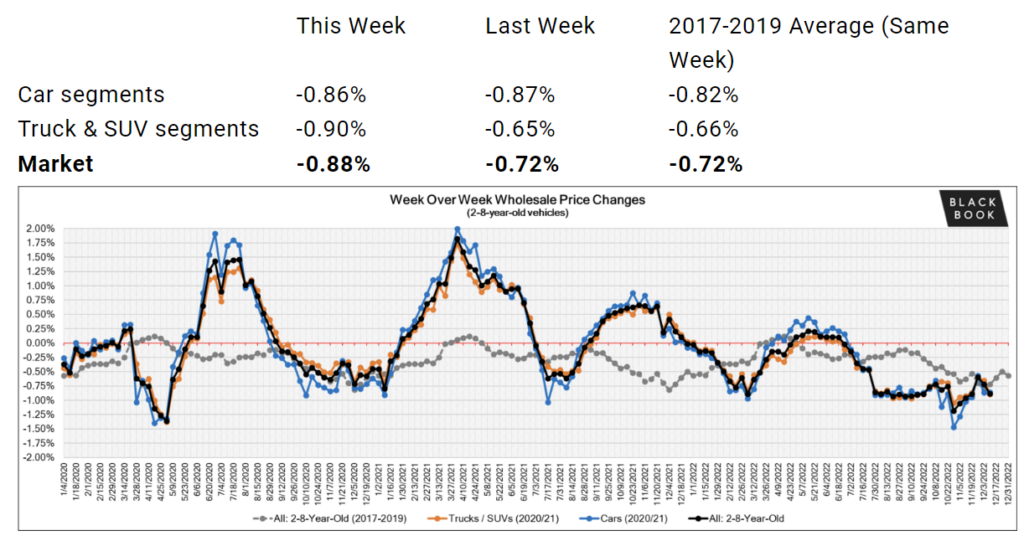
Through April , used car and SUV prices declined by ~5%. This was more depreciation than we’d expect in a “normal” year for the same time period. The rate of depreciation increased in February from January, however the trend reversed in March and April.
In May and June, we saw a reversal, with used car and SUV prices increasing week-over-week on the wholesale market. In December, the overall market is dropping, with no vehicle classes continuing to appreciate.
The overall wholesale used car market saw prices drop -0.88% last week. Cumulatively, used car prices have dropped -19% at the wholesale level over the past 6 months.
Mass-market car segments dropped the most last week. Compact and sub-compact cars dropped by over -1%, mid-size cars by -0.86%, and full-size cars by -0.43%. Overall luxury car prices fell by about 1% last week.
All used car segments saw declining prices last week, with an average of -0.86%. The week before, car prices were down -0.87%.
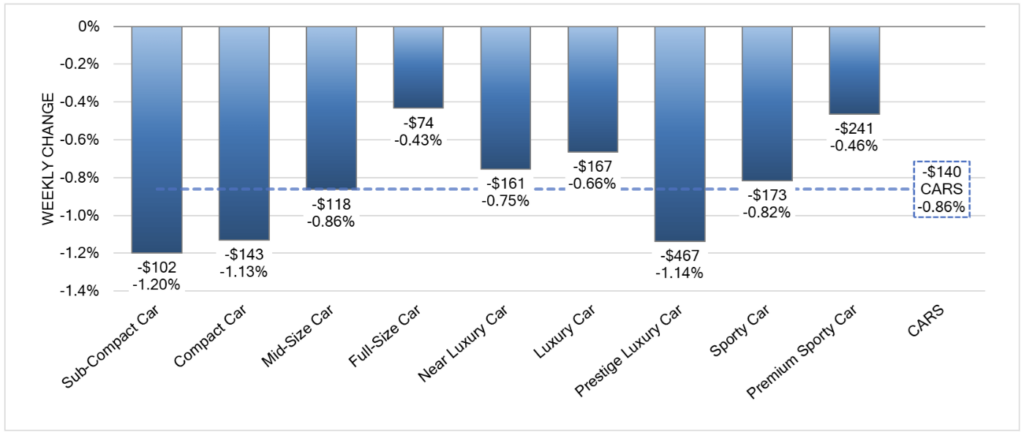
We are now seeing a sharp reversal in light-duty truck segments. The overall truck segment decreased -0.90% last week. Compact crossover prices declined the most, by -1.20%.
Mainstream crossover and SUV prices all fell by between -0.79% and -1.20% last week.
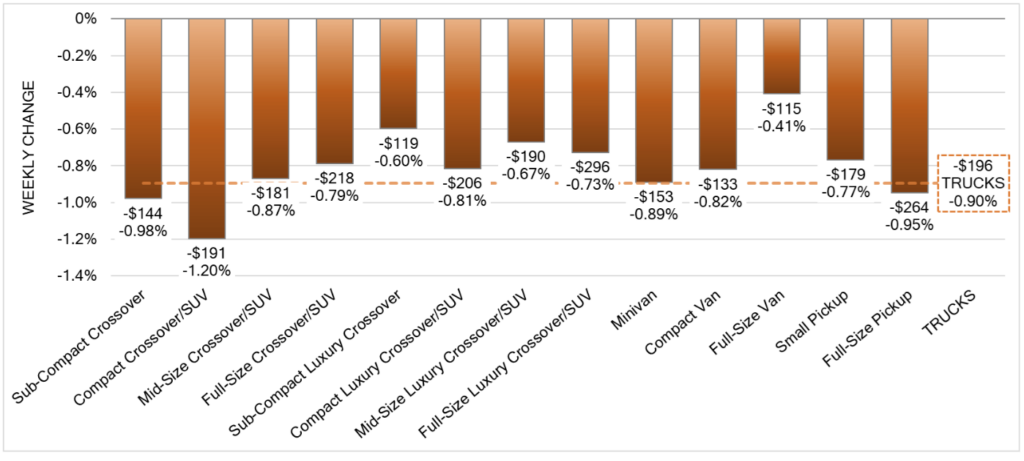
Since the onset of the pandemic, full-size vans have appreciated more than 60%. Now, we’ve seen wholesale full-size van prices drop about -5.0% in the past two months. This week, van prices dropped -0.41% in one week.
Year-Over-Year Prices Remain High

The graph below looks at trends in wholesale prices of 2-6-year-old vehicles, indexed to the first week of the year.
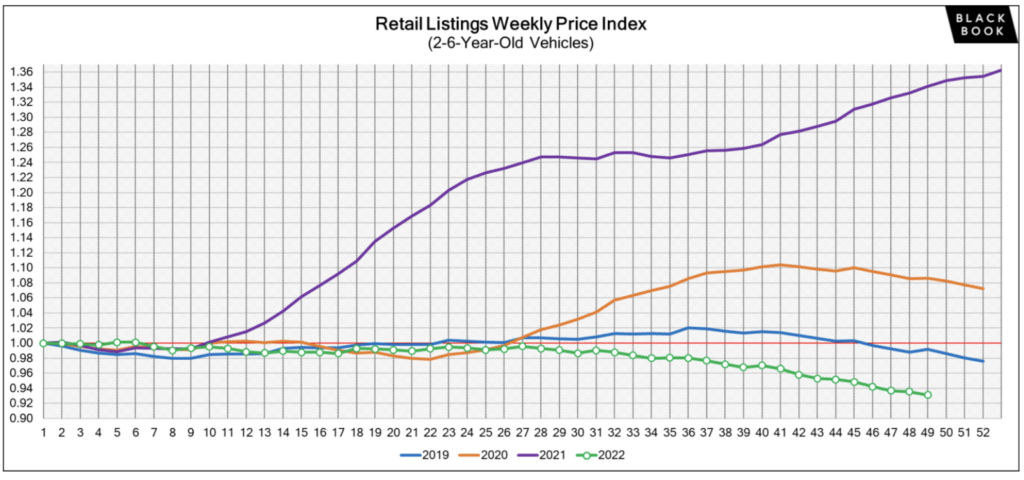
When will retail used car prices go down? Black Book’s weekly price index suggests that used car prices will steadily drop in 2023, after four months of slow but steady price declines in 2022. We expect prices to continue falling into 2023 due to the combined effects of higher interest rates restricting buying and the greater availability of new cars, which often have competitive promotional APRs.
We’re starting to see retail prices come down. Cars are also sitting on the lot for longer. As more vehicles sit on the lot, dealers will be more willing to negotiate.
Use this negotiation cheat sheet to stay in control of your deal
A new phenomenon we have begun tracking is that older used cars are appreciating more rapidly than younger used cars.
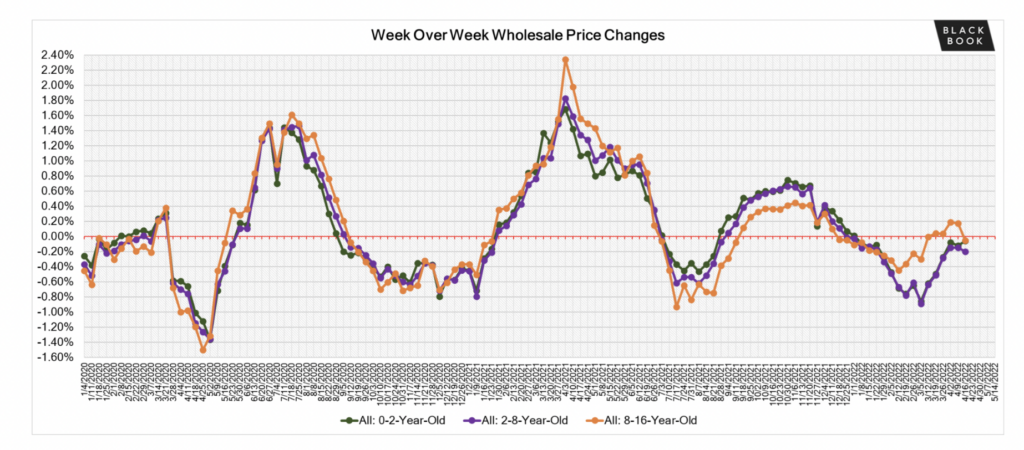
This is primarily a function of consumer demand. Retail customers that want to purchase a car at a sub $20,000 price-point are being forced to look at older used vehicles because the new ones have increased in value beyond their budget. This is scary, crazy, and a whole host of other words.
Wait until at least mid-September to buy a car. We expect to see retail prices decline beginning in early September, following eleven weeks of wholesale declines.
Used cars are sitting on the dealer lots for longer, and that creates better conditions for negotiating a better deal.
Sell as soon as you can. Used car prices are already dropping, and we expect retail prices to decline more in September.
To sell your car for the most money, be sure to read this guide.
Depending on who you ask (Cox Automotive, Edmunds, CarGurus, or Black Book), retail used car prices increased anywhere from 32% to 36% in 2021.
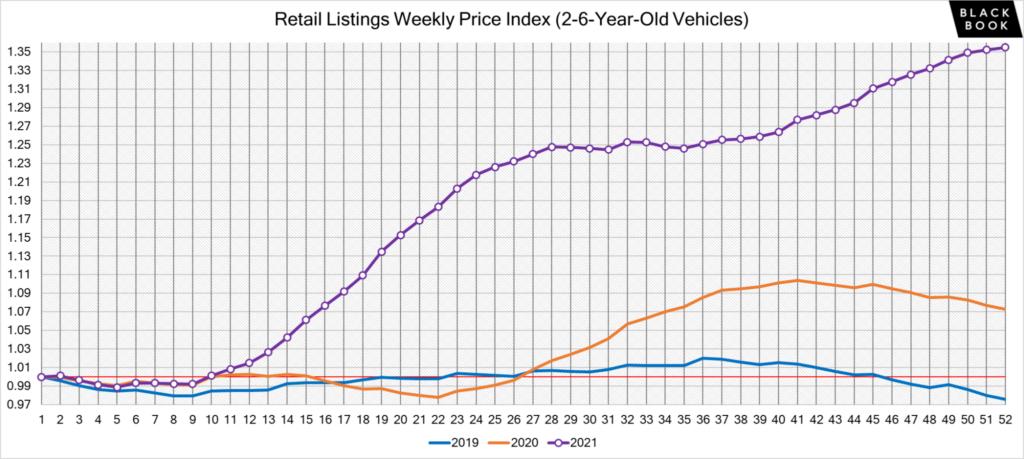
Black Book shows a 35% increase in retail used car prices for 2021 (the purple line). For comparison, the orange line shows a 7% appreciation for used car prices in 2020, and the blue line shows a 3% depreciation of used car values for 2019.
Here’s a month-over-month table showing used car price trends for 2021:
| Month | Average Used Car Price |
| January | $22,112 |
| February | $21,573 |
| March | $21,343 |
| April | $22,568 |
| May | $24,414 |
| June | $25,101 |
| July | $25,500 |
| August | $25,890 |
| September | $26,548 |
| October | $27,067 |
| November | $27,569 |
| December | $29,000 |
This data, supplied by Cox Automotive, shows the incredible ascent used car prices took in 2021.
Different types of vehicles have appreciated more than others. Vans have increased in value the most of all used cars. Take a look at this chart and data from CarGurus.
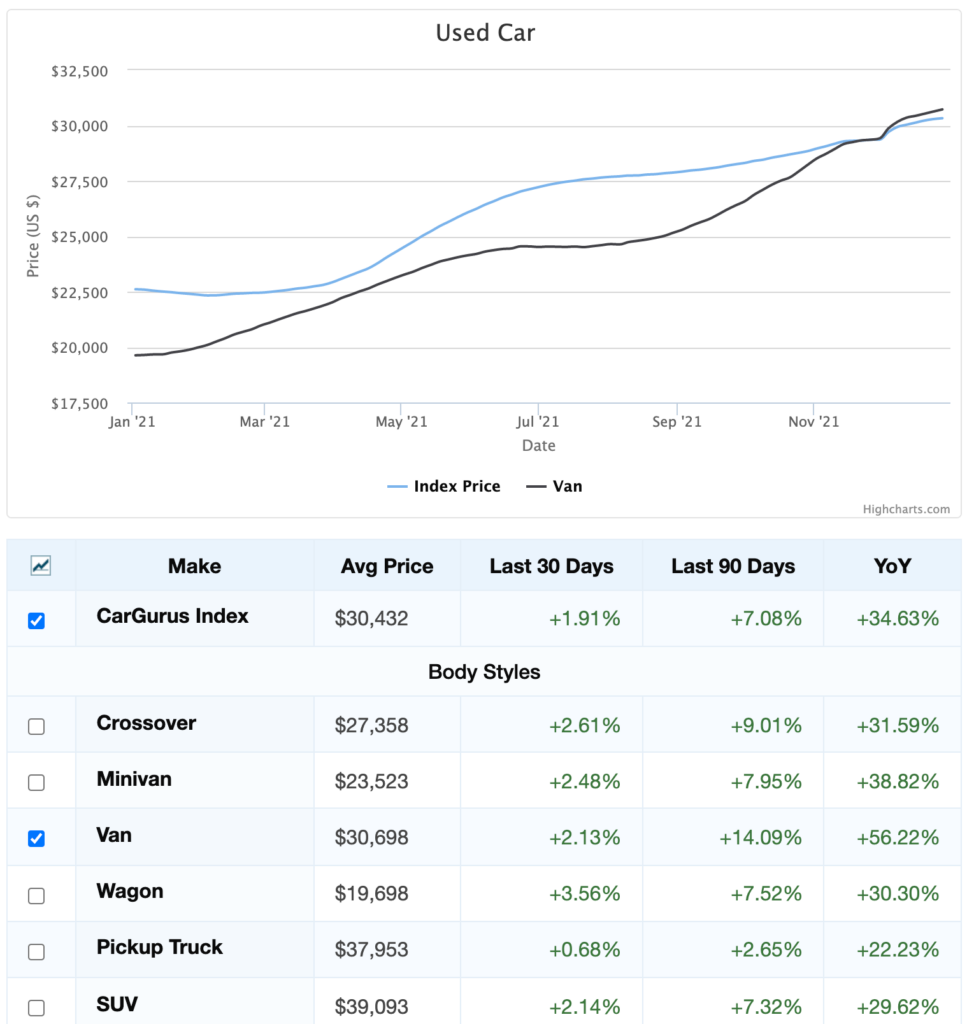
In 2021 used van prices increased over 56%, whereas CarGurus’ data showed a more modest (yet still insane) 34% increase for used car prices in general.
Used van prices have increased the most across vehicle segments for a few reasons:
For these reasons, and many more, used van prices have increased the most of any segment of vehicle.
Every used car has two prices; the wholesale price, and the retail price. As consumers we typically concern ourselves with the retail price, and with good reason, unless you have a dealer’s license you can’t buy a car wholesale at an auction.
That being said, wholesale used car prices are the lifeblood of car dealers, and the used car price trends we saw on the wholesale side in 2021 were truly unfathomable. While retail used car prices increased ~36% in 2021, wholesale used car prices rose 52%.
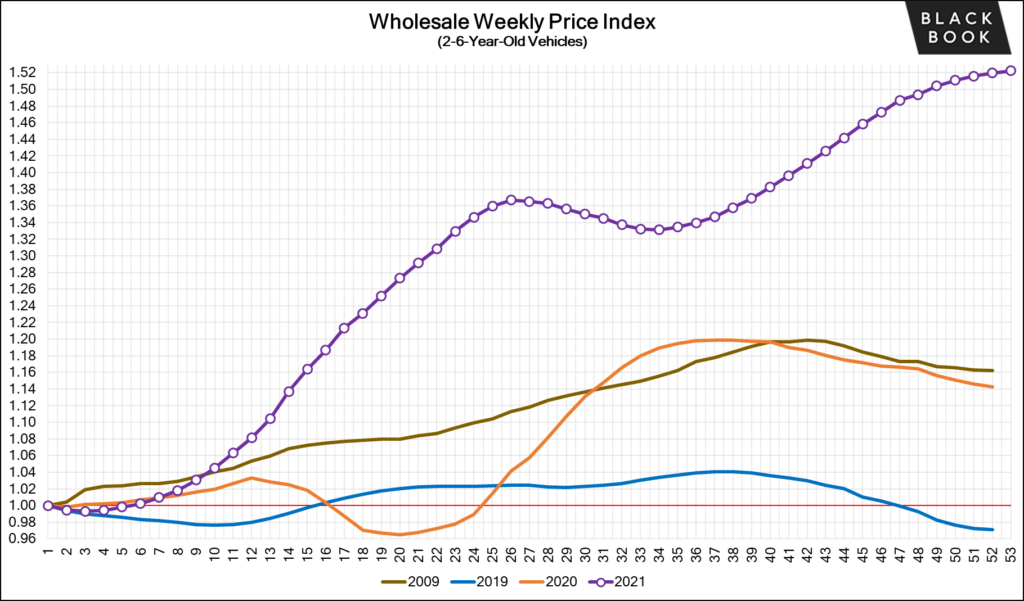
There is an obvious interplay between wholesale and retail prices. As wholesale prices increase, we can expect retail to prices to do the same. Here at CarEdge we are concerned that retail prices will stay highly elevated for a long time (potentially all the way through the fall of 2022) because car dealers will not want to discount their inventory that they grossly overpaid for earlier in the year.
Thanks to our friends at foureyes, we can share with you this real-time updating data set on used and new car prices.
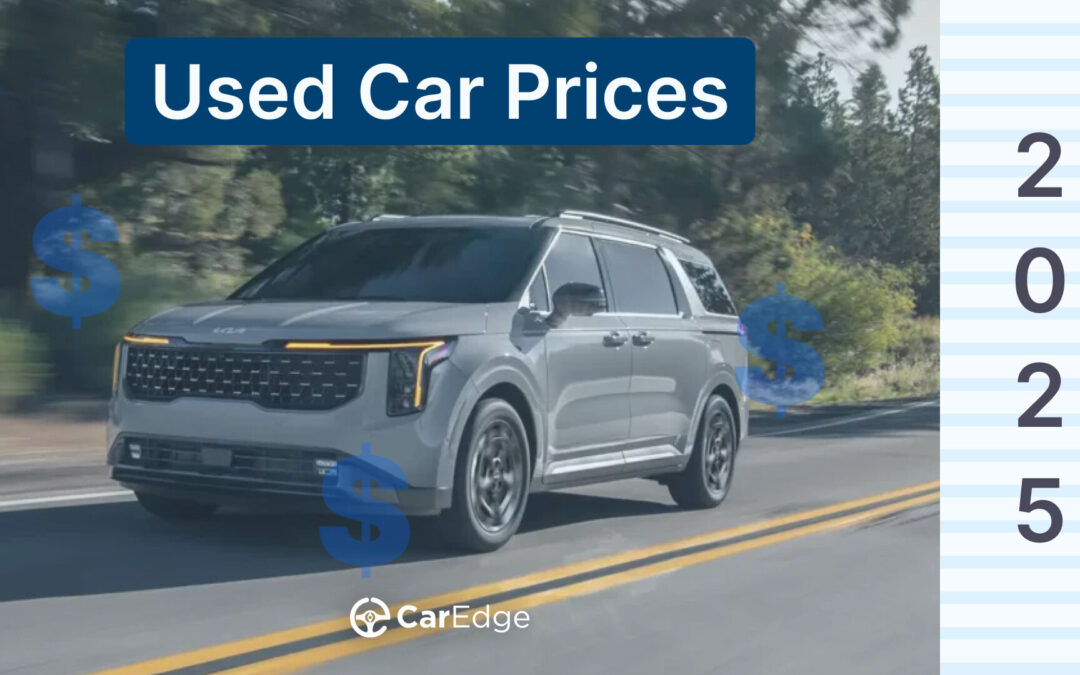
As we enter autumn, retail and wholesale used car prices are falling. In October 2025, the average used car listing price sits at $25,512. The car market is changing as year-end sales approach. This combination of seasonality and economic uncertainty means that used car prices will be difficult to forecast in the weeks ahead. With the continuing market volatility, it’s never been more important to track the value of your car.
👉 We also track new car prices. See the latest monthly update here.
As of October, used car prices have fallen for 25 consecutive weeks. According to the latest used car market data from Black Book, the used car prices are slowly but steadily falling at wholesale markets. These are the markets that most car dealerships buy and sell preowned inventory from. Will retail used car prices continue dropping? We’ll get into that below. First, let’s take a closer look at wholesale prices last week.

This week, wholesale used car prices continue a steady decline as the year-end car buying season appears on the horizon. That’s a great sign for buyers looking for lower prices in the weeks ahead.
In the first week of October, wholesale used car prices fell – 0.26% according to Black Book data. This drop is on par with the historical average for this time of year, following several week of larger declines.
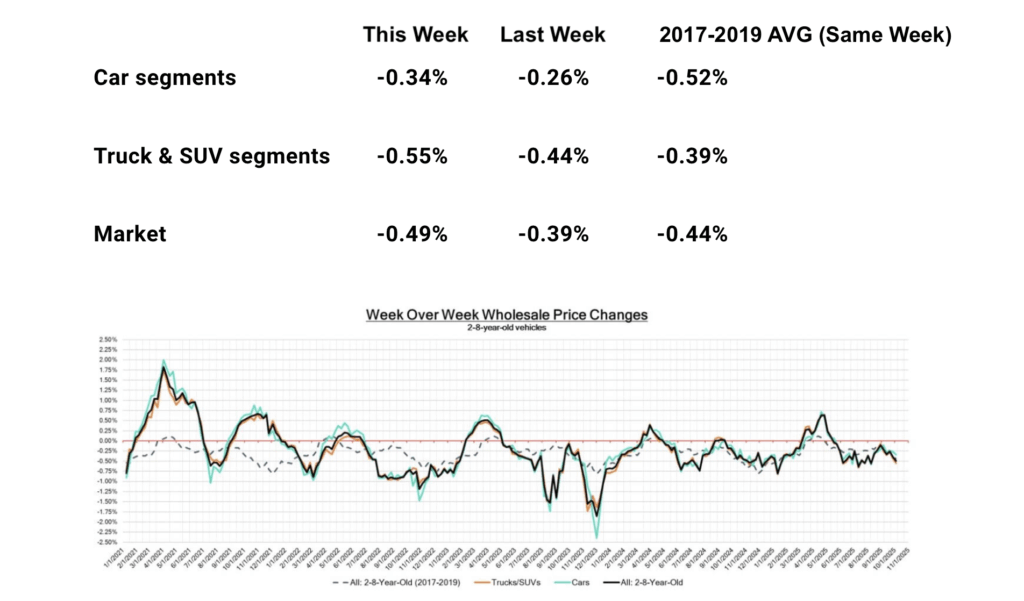
Which used car prices are falling most? Let’s take a look at the latest data from Black Book. We’ll break it down by vehicle segment below.
The overall car segment saw prices fall -0.34% this week. Most segments of sedans, from luxury to compact, saw falling prices. Midsize and luxury car prices fell the most, while full-size cars actually increased. Here’s how used car prices changed over the past week:
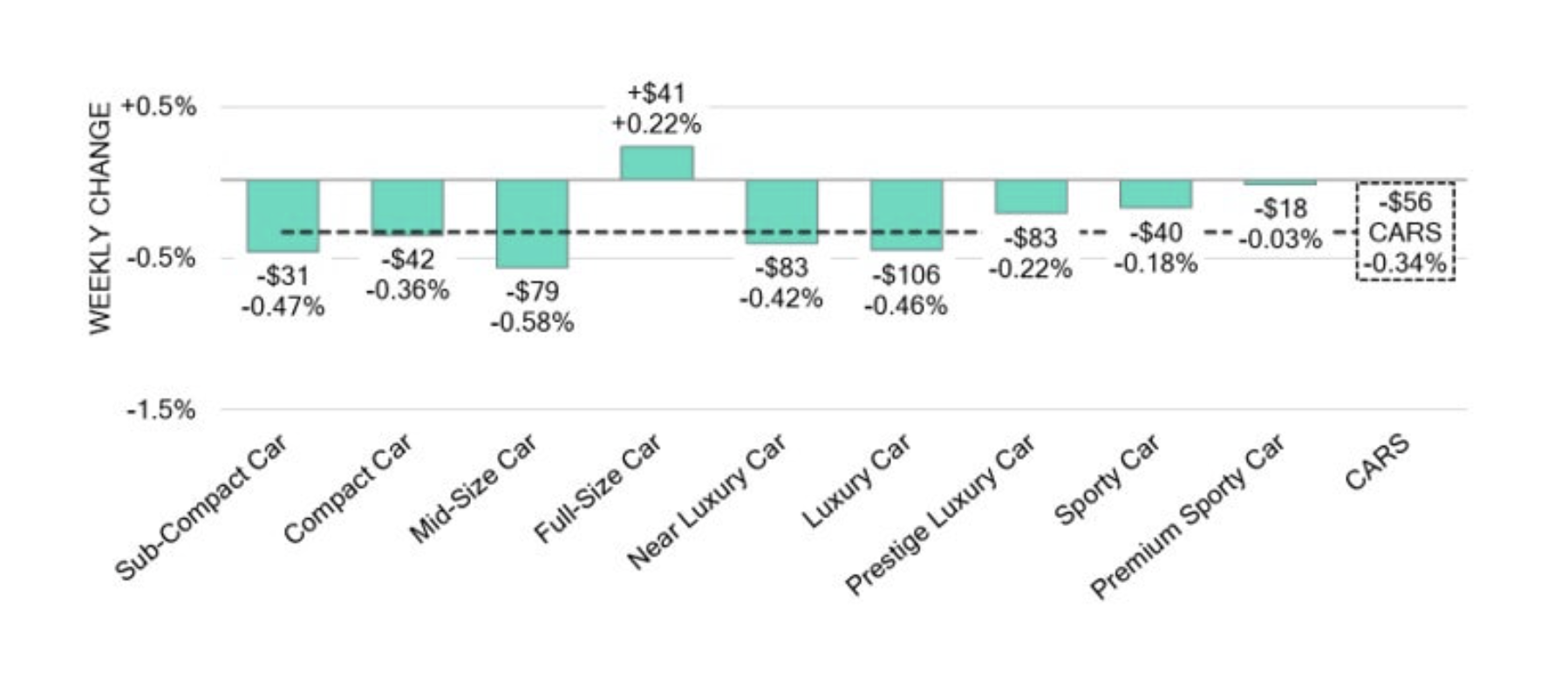
Used truck and SUV prices are falling in October 2025. No segments are falling sharply, but all are seeing moderate declines. Across the segment, wholesale prices fell by -0.55% last week. Buyers should expect better negotiability for used truck and crossover models as the year-end car buying season gets started. How so? Car buyers tend to focus on new car incentives during this time, lowering the demand for used cars. Buyers can use this to their advantage.
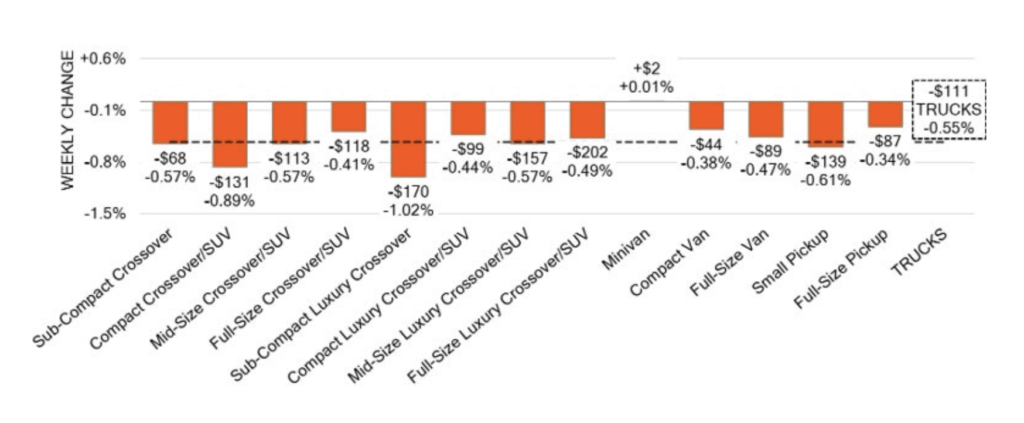
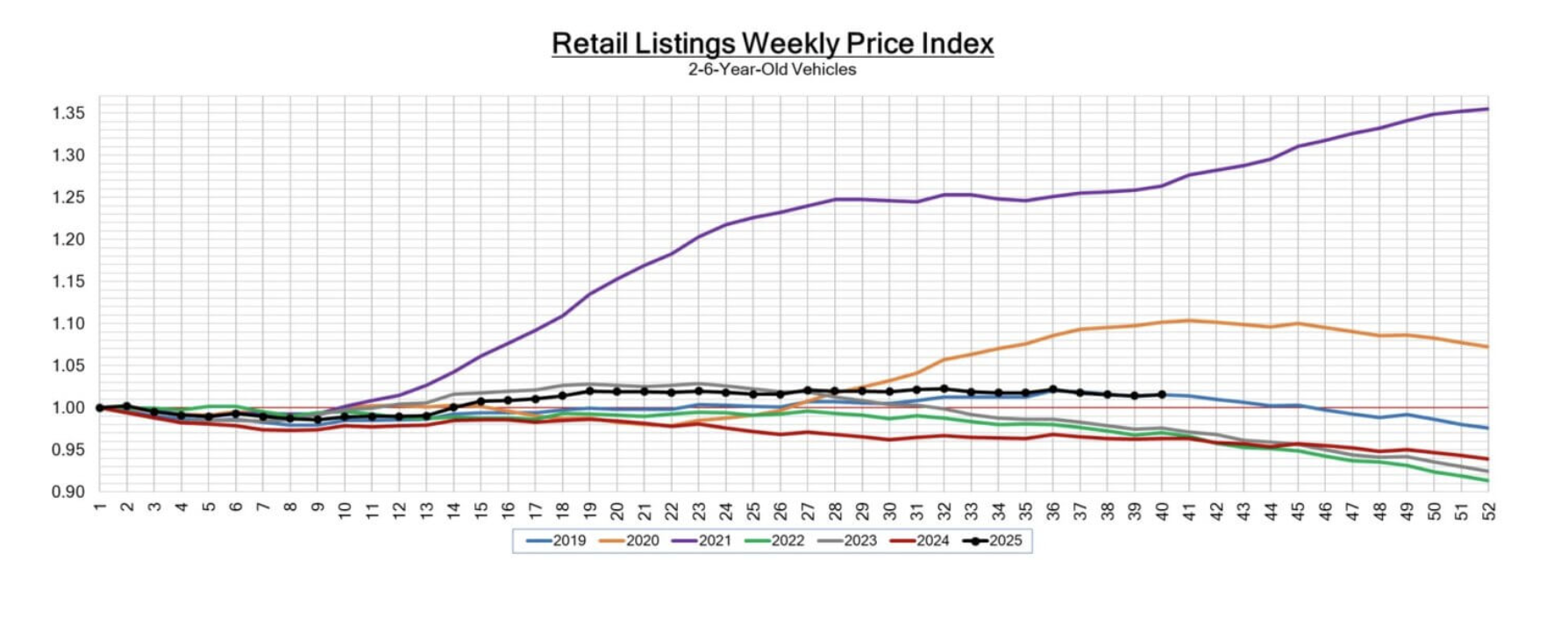
As the data above shows, retail used car prices are basically unchanged in early October. Historically, used car prices fall during the autumn and winter months. We’ll be watching to see if that trend continues in 2025.
Lower interest may drive the demand for used cars higher in the coming months. This is something that both buyers and sellers should be aware of. Sellers are likely to have an easier time selling come December and beyond, while buyers will face increased competition.
Used cars are selling faster than they have in recent years. In the graph below, you can see how the retail days-to-sell metric has been falling over the past few months.
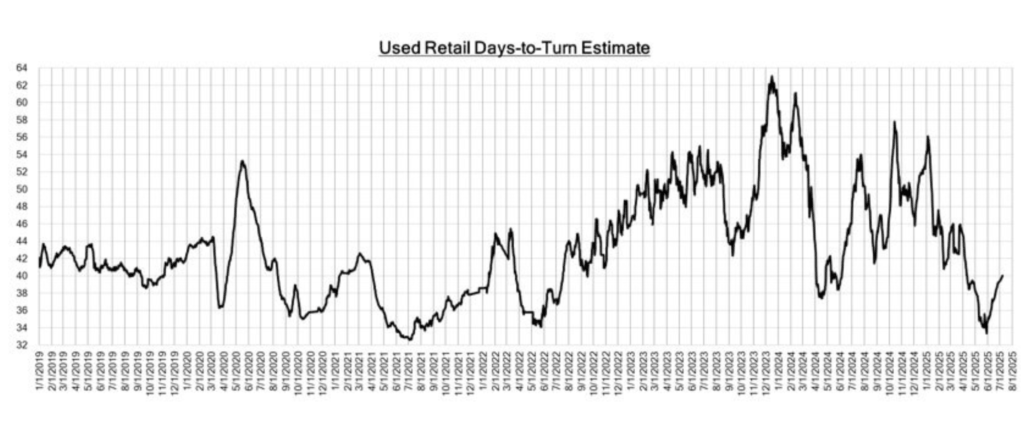
According to Black Book, the estimated Used Retail Days-to-Turn is now at 36 days. In other words, it take 36 days to sell a used car on average in 2025. Late last year, this number was north of 55 days. It’s interesting to note that used car prices are falling as the time to sell has fallen sharply. Usually, we’d expect to see the time to sell increase as prices fall. Of course, cars in higher demand will sell quicker, and those with less demand can take considerably longer.
New Car Price Trends (Monthly Updates)

Ready to outsmart the dealerships? Download your 100% free car buying cheat sheets today. From negotiating a deal to leasing a car the smart way, it’s all available for instant download. Get your cheat sheets today!
A new phenomenon we have begun tracking is that older used cars are appreciating more rapidly than younger used cars.

This is primarily a function of consumer demand. Retail customers that want to purchase a car at a sub $20,000 price-point are being forced to look at older used vehicles because the new ones have increased in value beyond their budget. This is scary, crazy, and a whole host of other words.
How did used car prices get so high? To find the answer, we simply need to remind ourselves of the car shortages of 2021. Depending on who you ask (Cox Automotive, Edmunds, CarGurus, or Black Book), retail used car prices increased anywhere from 32% to 36% in 2021.

Black Book shows a 35% increase in retail used car prices for 2021 (the purple line). For comparison, the orange line shows a 7% appreciation for used car prices in 2020, and the blue line shows a 3% depreciation of used car values for 2019.
Here’s a month-over-month table showing used car price trends for 2021:
| Month | Average Used Car Price |
| January | $22,112 |
| February | $21,573 |
| March | $21,343 |
| April | $22,568 |
| May | $24,414 |
| June | $25,101 |
| July | $25,500 |
| August | $25,890 |
| September | $26,548 |
| October | $27,067 |
| November | $27,569 |
| December | $29,000 |
This data, supplied by Cox Automotive, shows the incredible ascent used car prices took in 2021.
Every used car has two prices; the wholesale price, and the retail price. As consumers we typically concern ourselves with the retail price, and with good reason, unless you have a dealer’s license you can’t buy a car wholesale at an auction.
That being said, wholesale used car prices are the lifeblood of car dealers, and the used car price trends we saw on the wholesale side in 2021 were truly unfathomable. While retail used car prices increased ~36% in 2021, wholesale used car prices rose 52%.

There is an obvious interplay between wholesale and retail prices. As wholesale prices increase, we can expect retail to prices to do the same.
Thanks to our friends at foureyes, we can share with you this real-time updating data set on used and new car prices.
Understanding the history of a used car before you buy it is vital, but it can sometimes be difficult to get a full and accurate picture. Some sellers may lie about the condition of a vehicle or simply not remember everything that’s happened to it. This is where a CarFax report comes in.
We always recommend getting a pre-purchase inspection on any used vehicle you are considering purchasing, however at a bare minimum you need to get your hands on the vehicle’s history report.
What is a CarFax report? It’s a simple document that sheds light on the entire history of a given vehicle, starting from the time that it was manufactured. Understanding all of this information can help you to decide whether you want to buy the car, assist in negotiations, and let you understand what to expect from the car in the future.
Let’s take a look at what else you can learn from these important reports.
CarFax was founded in 1984 as a method to use data center tools to track and prevent odometer fraud. These days, CarFax maintains a database of over 6 billion vehicles in the United States and Canada.
An individual consumer or dealership can pay a fee to CarFax, along with the VIN for the car in question, and CarFax will present a detailed report about that vehicle.
So what’s on a CarFax report? There’s usually plenty of data to help consumers make an informed purchase decision. The data from CarFax comes from over 100,000 different sources. Much of the data on a CarFax report comes from police departments, since they are the first responders that handle major and minor car accidents. Other sources of data include insurance companies and auto body shops.
CarFax reports are broken down into several important sections. The section that’s particularly important for private sales is labeled “Title.” This is where the Department of Motor Vehicles’ information is listed.
Ensuring that the owner shown on the title matches the name of the person you’re buying from (if you’re not buying from a dealership, that is) will go far in keeping you out of trouble. This section will also inform you if the car has a salvaged title. It can even tell you if the car has been reported as stolen (run the other direction if it is).
Salvaged titles are not necessarily a lost cause. A salvage title means that the vehicle was in an accident and was declared to be totaled by an insurance company. After it was declared to be totaled, someone else took it upon themselves to repair the vehicle and put it back on the road. Salvaged vehicles might not have anything wrong with them, but you should still be wary of getting into a salvaged vehicle, since there are likely to be a lot of unknown factors.
The next section on the CarFax vehicle history report will simply list the mileage of the vehicle. It’s okay if there are some differences here, but they should be minor. Any major difference in the mileage is a red flag and could indicate odometer fraud. Typically speaking, though, differences in the mileage report only mean that the record hasn’t been updated as further miles were driven.
A CarFax report will also list how many owners the car has had. In an ideal world, you would want to buy a car with as few owners as possible. Generally, this means that the car hasn’t been passed around too frequently. A car with too many owners is a mild red flag, as this can be associated with certain types of fraud. Take note that CarFax does not collect nor report the names and addresses of previous owners.
On top of understanding how many people have owned the car, you’ll also learn whether the vehicle was used commercially, in a lease, or as a ride-sharing vehicle. This information can help you to understand what you’re getting into, since commercially owned vehicles will generally have more miles and may have been treated a bit rougher in the past. A ride-sharing vehicle can have its own problems, too, including a more worn interior and rougher suspension.
On a CarFax vehicle history report, you’ll learn if there are any active recalls that pertain to the vehicle. If you see a major recall affecting the target vehicle, ask whether it’s been addressed. If not, ask for a discount, since you’ll have to deal with the recall.
Most recalls are for a specific component. If a component has been recalled, it means that the car needs to be taken into a dealership for service. If you buy a used car and immediately have to address a recall, it can be a significant inconvenience (which often means it’s a good idea to ask for a discount).
Most importantly, a CarFax vehicle history report will tell you the accident history of the target vehicle. Details about the accident should be provided as well. Understanding whether a vehicle has been in an accident can help you to make your purchase decision. If you do proceed with the purchase, you can use the accident as leverage during the negotiations.
CarFax will let you know whether any car accidents resulted in airbag deployments or severe structural damage. If you see either of these types of damage listed, you should proceed with extreme caution. But even if you see a severe collision listed on a CarFax report, you should ask questions about the accident and ask for documentation about the repairs.
While collisions are certainly the main source of damage to cars, they are not the only one. A CarFax report can also show if there was any significant damage from fire, hail, or floods. Hail damage can be repaired without much issue, but stay away from cars that have been in a fire or a flood. Both of these types of damage can compromise the safety of the vehicle and result in costly repairs down the road, even if the initial damage was already repaired.
You’ll often hear people say that a certain car has a “clean” CarFax report. This means that there was no information found that was concerning.
It’s worth noting that a clean CarFax report doesn’t mean that the vehicle is perfect and worthy of being purchased. Sometimes, information can be misreported or otherwise mishandled so that it doesn’t show up on a CarFax report. For example, this might happen if someone failed to report a fender bender.
Other times, data may not show up because it didn’t come from the right sources. For example, an auto body shop might report that they worked on a car and replaced the rear fender, but if their report didn’t contain any information about the accident that caused the damage in the first place, it may not show up on the CarFax report as an accident.
It’s a good idea for anyone that is buying a used car to purchase a CarFax report before they sign on the dotted line. Many car dealerships are happy to provide a copy of the CarFax report for the vehicles that they sell.
You need to do everything you can to make sure that you’re buying a worthy vehicle, not a lemon that’ll break down on you next week. Test drives are one way to do that, and pre-purchase inspections are another way. Consider CarFax reports to be yet another tool in your toolbox when you want to make sure that you’re getting a good deal.
If you see any red flags appear on a CarFax report, it’s up to you to bring it up to the seller. Ask them whether there is a reasonable explanation for the things that came up on the report. You may end up hearing a string of excuses, but in some cases, you may get information that can alleviate your concerns.
As of 2021, one CarFax report costs $39.99, with discounts for volume as you increase the number of reports. Considering how much you’re likely to spend on the car, this is a minor expense that’s usually well worth the cost, especially if you end up using the information to negotiate the purchase price for your vehicle.
If you’re working with a used car dealer, ask them to supply a CarFax report for the vehicle that you’re interested in. It’s in their best interests to show that they have confidence in their cars and they usually don’t mind paying the small fee. If they won’t provide you with a report, it might be time to move on to the next dealership.
If you’re working with a private seller, on the other hand, don’t expect them to provide you with a CarFax report — you’ll most likely have to purchase your own as part of your due diligence on the vehicle.
Remember to buy a pre-purchase inspection alongside your CarFax report, which can help you to have all of the information you need to make an informed purchase decision.
We love to hear success stories from the members at CarEdge. It’s great to see how people are putting our tools and information to use and securing excellent deals on their new purchases, sales, and trade-ins.
Today, we’re going to share a success story from Melissa. She doesn’t quite have her car in-hand due to the chip shortage, but she’s already secured a great price for her trade-in.
We’ll go over how she researched her negotiation, pushed when the dealership wouldn’t budge, and how she feels about the entire transaction. Let’s take a look at how Melissa negotiated the process and what she learned along the way.
Melissa tells us that she started researching which car to buy in 2020, but that she only recently found CarEdge in early 2021.
One of the first things that she remembers learning from us was that she needed to negotiate her trade-in and new car purchase as two separate transactions. Prior to that, she never thought it would be important to separate the two, and since she was about to trade-in her car, she was happy to learn a new trick.
Do you have a vehicle to trade in? Read the full guide to trading in your car.
After she signed up for CarEdge and became familiar with our dashboard, Melissa began to use our “trade in valuation” tool powered by Black Book, the same valuation book dealers use.. She tells us that she immediately put that into good use, since she was working with several dealerships at the same time.
On one of our live streams, Melissa had her deal picked to go through an examination with our trade-in analyzer. This is a segment in our live streams where we pick a member’s deal and analyze it live.
During this stream, she learned about some pre-trade negotiation strategies. Melissa also benefited from another CarEdge member, Larry R, who shared some insights into what the tax benefit would be if she traded her vehicle in versus selling it to Carvana or Vroom.
With all of these facts and figures in place, Melissa was ready to head to the dealership to complete some final negotiations on her trade-in.
Although she had done a lot of the legwork upfront via email, Melissa made an appointment to visit a car dealership to finalize selling her trade-in. She decided to try to get more value out of her trade-in.
The salesperson was visibly upset, since they had already prepared the paperwork. As such, they were dismissive of her attempt to negotiate. They tried to push her to sign the documents and move along with the sale that had been negotiated via email.
She didn’t give in, however. Melissa made it clear that she knew used vehicle prices were skyrocketing due to the microchip shortage and that this wouldn’t stop anytime soon. She told them that she knew that car dealerships tend to make more money on used cars than new cars and it would be worthwhile for them to pay more for the trade-in.
Her point was further cemented when she let them know that she had already received multiple quotes from online price books and other dealerships for her vehicle, so she knew what her trade-in was worth.
Having the trade-in value that was provided by Black Book, the same value the dealer was using, helped Melissa to understand the value she should be receiving for her trade-in. Her persistence paid off and the dealership ultimately caved in and gave her another $200 for her trade-in.
Melissa reported that on the same evening she traded her vehicle in, it showed up on the dealer’s website. The car dealership was asking for $3,690 more than what she received for it. Considering that a good part of that difference usually comes from reconditioning costs to prepare the vehicle for a new buyer, she was happy with the amount that she received from the deal.
Melissa is still waiting for her new car to be manufactured and shipped out. Unfortunately, the chip shortage has customers all around the world waiting for their cars to arrive. Melissa did not mention the make and model of the car that she’s buying, but we hope that she likes her new car when it comes in.
Melissa was very pleased with the value that she received for her trade-in. She’s grateful that she found our tools and was prepared to bring up the effect of the chip shortages at the dealership.
In her opinion, she’s saved over $4,000 compared to what she would have paid without CarEdge. We’re glad you negotiated a great price on your trade-in, Melissa!

Trading in your car can help you to buy a new car without having to put a large amount of money down. However, you need to keep in mind that dealerships will want to sell you a new car for as much as they can, while paying you as little as possible on your trade-in.
Today, we’re going to cover how you can use your trade-in to your advantage. We’ll discuss the best ways to boost your car’s trade-in value and give you tips on how you should negotiate while you’re at the dealership.
You’ve decided to trade in your car. What should you do next? Learning how to trade in a car is vital to getting the most bang for your buck. Here are your next steps.
Understanding how much a dealership should be offering is essential to successfully negotiating your trade-in value. You can use CarEdge Pro to gain an understanding of what similar cars are going for. It’s smart to bring printouts of your car’s fair value with you to the dealership to show that you’ve done your research.
There’s no need to give the car a new paint job, but fixing any cosmetic issues will go far in getting the most for your trade-in. It’s also worth cleaning the interior and exterior before you take the car to a dealership. Break out the shampoo for the carpets, go through a car wash, and fix any dents. You might be surprised how big of a deal this can be.
There are plenty of reasons to shop around at different dealerships. Every dealership will offer you a different amount for your car, and some will be more open to negotiating than others.
Make sure to obtain quotes from these dealerships for your trade-in and take them with you to the next dealership. Don’t lose them! These quotes — along with your used car values from CarEdge — will help you when it’s time to negotiate.
Once you have a firm understanding of your car’s value, have fixed any minor issues, and you’re prepared to shop around at multiple dealerships, it’s time to negotiate.

Avoid the temptation of negotiating your car trade-in value when you’re negotiating the price of a new car. You should negotiate both numbers separately. When you mix the negotiations, there’s too much potential for the salesperson to tweak the numbers so that it seems like you’re getting a better deal than you really are.
Your first order of business is to negotiate the price that you’ll pay for your new car. Once that is nailed down, then you can start talking about how much you’ll receive for your trade-in.
Use quotes from other dealerships and the Kelley Blue Book estimate to illustrate that you know what a fair offer looks like. Since many car dealerships will directly resell your trade-in on their used car lot, there’s an incentive for them to be competitive.
Stay firm in what you’ll accept. If they won’t give you a good price, then it’s time to leave that dealership. It’s worth taking your time to trade in a car the right way.
Timing matters when it comes to trading in your car. Being patient can often pay off. Factors such as weather, the type of car that you have, and other socioeconomic factors can come into play with the trade-in value that you receive.
For example, trading in an SUV that is in great condition right before winter can often result in a better trade-in value, as winter weather tends to drum up extra business from people that are looking for something that can handle snowy conditions. Think about the time of the year as it relates to what you’re offering.
Other factors can impact the sales process, too. It’s always better to try to buy a car at the end of the month or at the end of the year. That’s when car dealerships are trying to boost their numbers at the end of their sale periods. You’re likely to get a great price on your new car and a high trade-in value at these times.
Do your research to make sure that you know what your car is worth when you want to trade in a car. Stay firm on the amount that you’ll accept for your trade-in. Be aware that some dealerships may try to manipulate the numbers. Sometimes, what looks like a good deal on your trade-in is made up for with a bad deal in another area.
Remember, you can always say “no” and walk out of the dealership. It’s your car and you deserve to get a great deal.